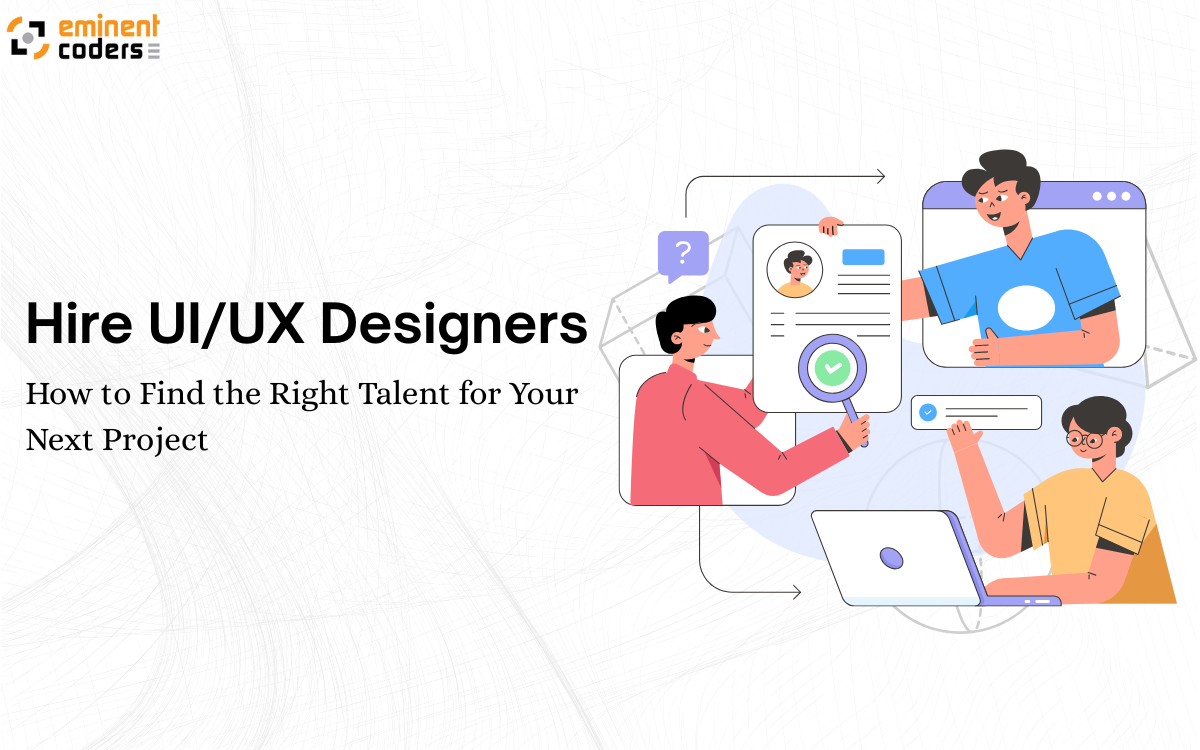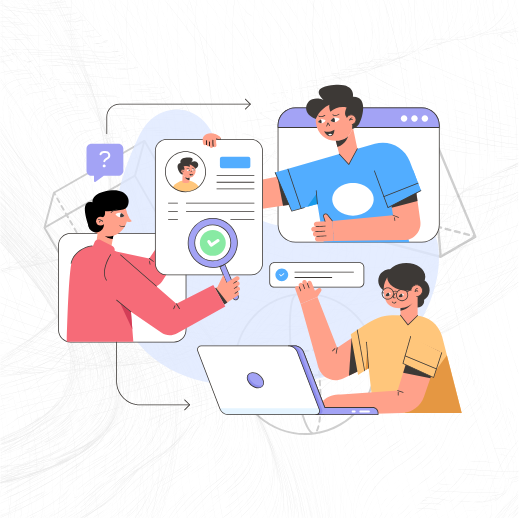Hire UI/UX Designers: How to Find the Right Talent for Your Next Project

Finding and hiring great UI/UX designers can make or break your product. Whether you’re building an MVP, redesigning an enterprise dashboard, or improving conversion on an e-commerce site, the right designer brings clarity, empathy, and measurable results.
This guide shows you a practical, research-backed approach to hire UI/UX designers who fit both the project and your team — from where to look, what to test, to onboarding and retention.
If you’re still deciding whether to build an in-house team or just bring in one expert, check out our guide on Hire Ui UX Designer to understand the pros and cons of both approaches.
Why you should carefully hire UI/UX designers
Good UI/UX design reduces friction, increases engagement, and saves development time. Hiring casually often leads to rework, product confusion, and missed opportunities. Investing time into a robust hiring process gets you designers who understand business goals, user psychology, and modern design systems — not just pretty interfaces.
Where to find top candidates when you hire UI/UX designers
1. Niche communities and portfolios
Design portfolios matter. Explore Dribbble, Behance, and designer-specific communities (UX Collective, Designer Hangout). Look for case studies that explain the problem, research, decisions, and outcomes — not only pixel mocks.
2. Product-focused platforms
Product-Market Fit projects need product designers who understand metrics. Use platforms like LinkedIn (with targeted filters), AngelList for startups, and specialized job boards (e.g., WeWorkRemotely, RemoteOK) for remote talent.
3. Referrals and local meetups
Referrals from developers, PMs, or other designers often produce high-quality hires. Attend local UX meetups, design talks, or run hackathons to meet candidates in action.
4. Freelance marketplaces (selectively)
For short projects or trials, hiring via Upwork, Toptal, or Fiverr Pro can be useful. Look for designers with repeat clients and detailed case studies.
What to look for when you hire UI/UX designers
1. Strong case studies (not just screenshots)
The best indicator is a case study that includes: research methods, user insights, design iterations, trade-offs, implementation notes, and measurable results (A/B tests, conversion lift, time-on-task improvements).
2. Research-led mindset
A designer should show how they validate assumptions with user interviews, testing, or analytics. Ask for examples where user research changed the design direction.
3. Interaction & visual craft
Good visual design is necessary for trust and usability. Check prototypes for motion, micro-interactions, and clarity of states (disabled, hover, error).
4. Systems thinking and collaboration
Look for experience with design systems, component libraries, and cross-functional collaboration (with developers, PMs, QA). This signals scalability.
5. Soft skills & product sense
Communication, empathy, and the ability to explain design decisions to non-designers are critical. Product sense — knowing when to simplify, prioritize, or push back — is a key differentiator.
If you don’t want to go through the entire hiring process yourself, you can directly work with a dedicated team through our Ui UX Design and Development Services
Screening process: a practical funnel to hire UI/UX designers
Step 1 — Resume & portfolio pass (light)
Scan portfolios for at least 2–3 in-depth case studies. Discard portfolios that only show static images without context.
Step 2 — Short video or call (30 minutes)
Ask candidates to talk through one case study for 8–10 minutes. Listen for clarity, ownership, and ability to justify decisions.
Suggested prompt: “Walk me through a project where user research changed your final design. What did you learn and what changed?”
Step 3 — Design task (paid, realistic)
Give a scoped, paid design task that mirrors real work. Keep it time-boxed (6–10 hours). Avoid artificial “redesign this homepage” questions; instead, present a realistic user problem with data.
Deliverables: 1–2 user flows, low-fi wireframes, 1 interactive prototype, short rationale (250–400 words).
Step 4 — Team interview (60 minutes)
Include a developer and product manager. Discuss handoff process, responsive strategies, and how they handle constraints.
Step 5 — Reference check & offer
Talk to former managers or collaborators. Verify delivery, communication, and adaptability.
Interview prompts & red flags when you hire UI/UX designers
Good interview prompts
-
“How did you measure the impact of your design?”
-
“Describe a time you disagreed with a stakeholder. What happened?”
-
“How do you approach accessibility in your designs?”
-
“Show a before/after where your design improved a KPI.”
Red flags
-
No process or vague answers about research.
-
Portfolios with only polished images and no context.
-
Overreliance on tools (Figma/Sketch) without UX rationale.
-
Defensive attitude about feedback or iteration.
Compensation, contracts, and engagement models
Decide early: full-time, contract, or freelance. For hiring clarity:
-
Full-time: best for long-term product growth and ownership.
-
Contract/freelance: ideal for focused projects (MVP, landing page).
-
Part-time/retain: good for steady design needs without a full hire.
Contract checklist:
-
Scope & deliverables
-
Timeline & milestones
-
Ownership of files & IP
-
Handoff expectations (components, tokens, documentation)
-
Acceptance criteria & revisions
-
Payment schedule (milestones or time-based)
Onboarding & retaining top talent after you hire UI/UX designers
A great hire becomes excellent with supportive onboarding:
-
Give business context: metrics, user personas, past research.
-
Access tools: analytics, design system, code repo.
-
Pair with a developer for early handoff alignment.
-
Set clear goals for first 30/60/90 days (deliverables + discovery).
-
Encourage feedback loops and autonomy.
Retention tips:
-
Career growth (ownership of features, leadership opportunities).
-
Continuous learning budget and design critiques.
-
Respect for design-time — avoid last-minute scope creep.
Quick checklist: Before you hire UI/UX designers
-
Portfolio with 2+ detailed case studies.
-
Evidence of user research and outcomes.
-
Paid design task for final evaluation.
-
Cross-functional interview panel included.
-
Clear contract and acceptance criteria.
-
Onboarding plan and 90-day goals.
FAQ — Frequently asked questions about Hire UI/UX Designers
Q: How much should I budget when I hire UI/UX designers?
A: Budget varies by region, experience, and engagement type. For full-time hires, expect a significant salary range depending on market. For contracts, set a scope-based fixed-price or hourly with a capped number of hours and a paid design task to confirm fit.
Q: Can I hire a junior designer and train them?
A: Yes. Juniors are cost-effective if you have a senior designer or product lead to mentor them. Ensure a structured onboarding, clear milestones, and a mentorship plan.
Q: What’s the difference between UI and UX when I hire UI/UX designers?
A: UX focuses on user research, flows, and usability; UI focuses on visual design and micro-interactions. Many product designers do both, but complex products may need specialists for research or motion design.
Q: Do portfolios lie? How do I verify claims when I hire UI/UX designers?
A: Ask for explainer calls where the candidate walks through their specific contributions. Reference checks and a paid test project are the best verifications.
Conclusion: Hire UI/UX Designers the Right Way
Finding and hiring the right UI/UX designer is not just about filling a role — it’s about creating user experiences that grow your business. A structured hiring process, clear evaluation criteria, and smooth onboarding will help you get the most out of your investment.
If you are ready to transform your product experience, explore our UI UX Design Services and work with our expert team to design interfaces that your users will love.






